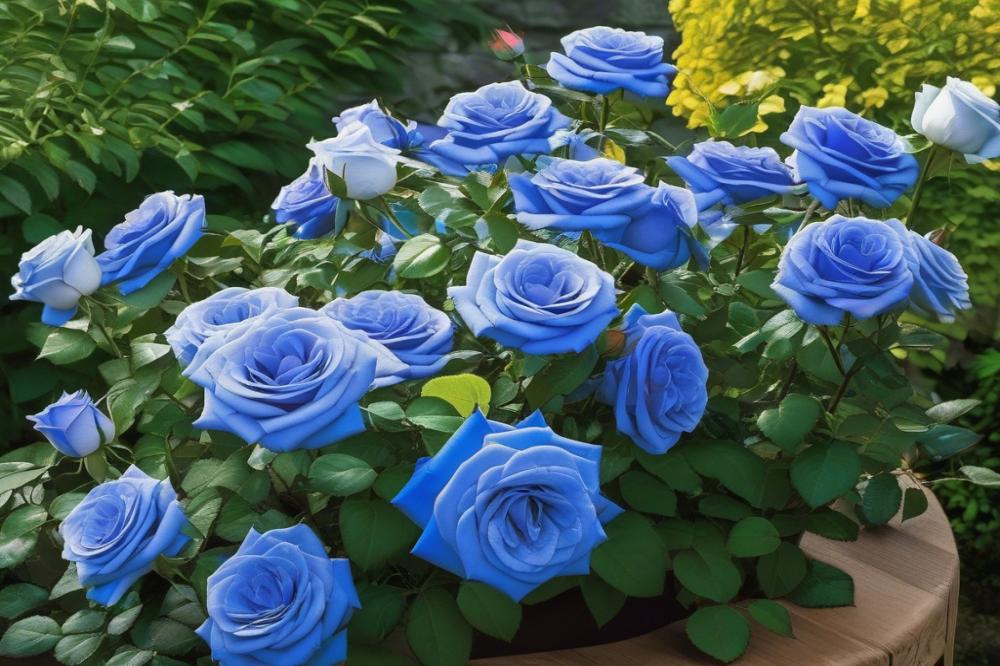Exploring the Allure of Blue Roses
Blue Roses capture the imagination with their striking color and deep symbolism. These flowers are often associated with mystery and the unattainable. They symbolize love at first sight, making them a sought-after choice for special occasions. However, it’s important to note that true blue roses do not naturally exist. Instead, hybrid roses have been developed to achieve this captivating hue. Their charm makes them a fascinating topic in the gardening world.
Taking care of roses is essential to maintain their beauty and health. Proper rose care involves understanding the specific needs of each variety. Gardeners who master flower gardening techniques can elevate their gardens to new heights. Some key aspects include soil requirements, watering needs, and fertilization. Each of these elements plays a critical role in maintaining vibrant and healthy roses.
This article will delve into the various aspects of Growing Blue Roses. Topics will include essential gardening tips, rose bush maintenance, and more. You’ll learn how to control pests and enhance blooms. By the end, you’ll have a comprehensive understanding of blue flower care and how to make these stunning blossoms thrive in your garden. Prepare to transform your gardening skills and create a breathtaking floral display!
Understanding Blue Roses

Many people admire blue roses for their captivating appearance. These flowers have a fascinating background rooted in genetics. True blue roses do not occur naturally in the world. This is because the rose plant lacks a specific pigment called delphinidin, which is responsible for producing a blue color. However, many gardeners dream of seeing these lovely blooms in their gardens.
When discussing blue roses, it’s essential to differentiate between true varieties and dyed options. Artificially colored roses are created by inserting them into dye solutions. This method provides vibrant hues that appeal to many buyers, but they can only last for a short time. They don’t possess the qualities of actual blue roses, which can make caring for them quite different.
Hybrid roses play a significant role in the quest for achieving blue shades. Scientists have worked hard to produce hybrids that exhibit varying degrees of bluish tint. Through careful breeding and sometimes genetic engineering, they’ve made progress, although completely blue flowers remain elusive for now. Growing hybrid roses often requires specific rose care routines that differ from standard red or yellow varieties.
For successful flower gardening, consider the unique soil requirements of hybrids. Well-draining soil is crucial to prevent root rot. When growing these plants, regular pest control is necessary to keep them healthy. Fertilization should not be overlooked as it helps boost their growth and flower production. Additionally, always pay attention to their watering needs, as too much or too little can impact the plant. Careful attention to these factors will improve your chances of growing beautiful roses, no matter their hue.
In the end, understanding the complexity behind these flowers not only enriches your gardening knowledge but also prepares you for flower bush maintenance. By grasping the concepts of hybridization and artificial coloring, you can make informed decisions about what to plant in your garden.
Soil Requirements for Blue Roses

Growing stunning blue roses starts with the right soil type. A loamy soil is ideal as it holds moisture while allowing for proper drainage. Organic materials like compost can greatly enhance the soil structure. This composition supports the roots and promotes healthy growth.
Best Soil Types for Growing Blue Roses
Well-drained soil is essential for any rose bush maintenance. Sandy loam or clay loam are top choices for flower gardening. These types prevent waterlogging, which can cause root rot. Amending with peat moss or well-rotted manure also increases drainage and aeration.
Importance of pH Levels and Nutrient Content
Check pH levels routinely, as they play a critical role in growth. Blue roses thrive best in slightly acidic soil, with a pH ranging from 6.0 to 6.8. Nutrient content matters as well. Ensuring the soil is rich in nitrogen, phosphorus, and potassium will support the demands of hybrid roses. Regular soil tests help you keep track of nutrient levels.
Tips for Amending Soil for Optimal Health
Improving your garden’s soil can be surprisingly simple. Start by incorporating organic matter to boost fertility. Cover crops or green manures can enrich the soil during off-seasons. Mixing in compost not only enhances nutrient content but also improves soil structure.
Furthermore, consider mulching around the plants to retain moisture and suppress weeds. Adequate pest control measures should also be in place. Always aim for a balance between moisture and drainage. Blue flower care demands diligence, especially when it comes to watering needs.
Lastly, don’t overlook the importance of regular fertilization. High-quality fertilizers tailored for roses can provide essential nutrients. Apply them according to the instructions to avoid any adverse effects on your plants. Following these steps will lead you towards a thriving garden of luxurious blooms.
Watering Needs and Fertilization

Establishing the right watering schedule is vital for the health of your rose bushes. Roses require consistent moisture to thrive, but overwatering can lead to root rot. A good method for determining when to water is to check the top inch of soil. If it feels dry, it’s time to give your plants a drink.
Ideal moisture levels play a key role in rose care. Soil should remain damp but not soggy. A well-draining mix will help maintain the necessary balance. After heavy rain, monitor the flower beds. Too much water can suffocate roots, causing them to weaken.
Recommended Fertilizers for Hybrid Roses
Choosing the right fertilizer can significantly improve your plant’s health. Hybrid roses benefit from balanced fertilizers that contain essential nutrients. Look for a formulation with nitrogen, phosphorus, and potassium. Additionally, organic options can be beneficial. They enrich the soil and support long-term growth.
Timing and Application Methods for Effective Fertilization
When it comes to application timing, spring and early summer are optimal. These periods promote robust growth during the growing season. Follow up with another feeding in late summer to encourage blooming. Use granules or liquid options based on your preferences.
For the best results, apply fertilizer evenly around the base of the bush. Avoid placing it too close to the roots, as this can cause burning. Watering after application ensures the nutrients penetrate the soil effectively.
In addition to watering and fertilizing, don’t forget about pest control. Keeping an eye on your plants will help you catch problems early. Overall, flower gardening involves careful attention to soil requirements and regular maintenance. Healthy roses are the reward for your efforts.
Rose Bush Maintenance

Pruning Techniques for Healthy Growth
Pruning is vital for rose care. It keeps plants healthy and encourages new blooms. Start by removing dead or damaged branches. Cutting back these parts lets sunlight in. Always use clean, sharp tools. This prevents disease from spreading. Trim about one-third of the plant each year. You want to shape it without overdoing it. Focus on thinning the center for better air circulation. Regular pruning helps your hybrid roses thrive.
Supporting and Staking Methods for Blue Rose Bushes
Support is crucial for healthy growth, especially for taller varieties. Use stakes to keep the stems upright. Choose wooden or metal stakes that will last. Drive them into the ground beside the plant. Gently tie the stems using a soft material. This protects the branches while allowing for some movement. Proper stakes also prevent breakage during storms. Adequate support is essential to maintain the bush’s form.
Seasonal Care Routines for Optimal Health
Each season requires specific attention to your flower gardening routine. During spring, focus on fertilization and watering needs. Apply a slow-release fertilizer to promote vigorous growth. As temperatures rise in summer, increase watering. Check the soil regularly to avoid drying out. Fall is the time for cleanup. Remove spent blooms and fallen leaves to prevent pests. Winter care is simple but necessary. Protect the roots with mulch to insulate against cold. Following these seasonal guidelines will boost your blue flower care efforts.
Pest Control and Disease Management
Common Pests That Affect Blue Roses and How to Identify Them
Like any other rose bushes, blue roses can suffer from various pests. Aphids are tiny insects that suck sap from the plants. They often appear in clusters on new growth. Look for distorted leaves and sticky residue on your plants. Spider mites thrive in dry conditions and can cause yellowing leaves. A telltale sign includes fine webbing on the undersides of leaves. Additionally, thrips can create dark spots and streaks on petals. Handpicking these pests or using insecticidal soap can be effective.
Organic and Chemical Pest Control Methods
Using organic methods is a great approach for rose care. Natural predators like ladybugs can control aphid numbers. Neem oil is another useful remedy; just mix it with water and spray on the affected areas. For gardeners preferring chemical options, insecticides can be effective too. Choose products specifically targeted for the pests you’ve identified. Always follow the instructions carefully to minimize harm to your plants.
Disease Prevention Strategies and Treatments
Alongside pests, diseases can threaten your roses. Fungal infections like powdery mildew often result from poor air circulation. Keep your plants spaced adequately apart to allow air movement. Watering needs are important too; apply water at the base rather than top watering. Copper fungicides can be beneficial if a fungal issue arises. Additionally, regularly inspect your plants for signs of trouble. Early intervention is key in protecting your hybrid roses.
Incorporating these essential tips into your flower gardening routine will support the long-term health of your rose bushes. Implementing proper soil requirements and attentive maintenance helps avoid many problems. Engage with your plants regularly to spot any potential issues before they escalate.
Gardening Tips for Blue Roses
Choosing the Right Location for Planting
Locating the perfect spot for your hybrid roses is crucial. Select a place that receives at least six hours of sunlight each day. Good air circulation helps keep the plants healthy. Most importantly, choose well-draining soil to avoid root rot. Sloped areas can be ideal, as they naturally shed excess water. Pay attention to the surrounding environment. Avoid areas with heavy shade or where water tends to collect after rain. Your rose bushes will thrive in a location that matches their needs.
Companion Planting Ideas for Blue Roses
Consider adding companions to create a vibrant flower garden. Lavender and catmint not only enhance the aesthetic but also repel pests. Marigolds are great picks; they attract beneficial insects while keeping harmful ones at bay. Planting these alongside your roses can create a beautiful contrast in colors. Other herbs like basil or chives can also serve as beneficial partners. They promote healthy growth and can even aid in pest control. A mix of colors and textures will make your garden visually pleasing.
Maintaining an Aesthetically Pleasing Garden Layout
A well-thought-out layout can enhance your blue flower care. Create layers by planting taller flowers at the back and shorter ones in front. Group flowers in odd numbers to add interest. This not only provides a natural look but also draws the eye to specific areas. Regular rose care is vital for keeping the garden appealing. Trim any dead or diseased parts to maintain shape and health. Incorporate pathways that allow for easy movement through your garden. A tidy space encourages more visitors, enhancing the overall charm of your flower gardening oasis.
Final Thoughts on Growing Blue Roses
Throughout this article, we have explored the fascinating world of cultivating stunning blue roses. You learned about the essential requirements for successful growth, such as ideal soil conditions, the right amount of sunlight, and proper watering techniques. Effective rose care is crucial for promoting healthy plants and vibrant blooms. Always remember that these flowers can be a challenge to cultivate, but their beauty makes the effort worthwhile.
We encourage you to experiment with this captivating flower. Try different techniques and watch how your plants respond. Enhancing your gardening skills often involves trial and error, so do not be afraid to make mistakes along the way. Each attempt can lead to greater understanding and eventual success.
In closing, growing blue roses is a rewarding endeavor. Their striking color adds a sense of wonder and elegance to any garden. By following the gardening tips outlined here and caring for your roses with patience, you too can enjoy the artistry of these remarkable blooms. Take joy in your gardening journey, and remember that every flower tells its own story.



